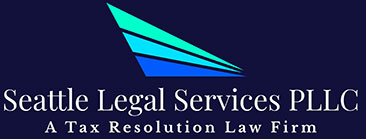Owe $50K or Less in Back Taxes? Check Out the Resolution Options

If you owe less than $50,000, you may be able to set up a payment plan online, and you may also be able to avoid a tax lien or other harsh collection actions. The IRS has many different resolution options for this level of tax debt, and in some cases, people even make a significant payment to get their balance below this level so that they can take advantage of these options.
To get guidance on the best options for your situation, contact us at Seatle Legal Services today. We can help you regardless of your level of unpaid taxes.
Online Payment Plans for People Who Owe $50K or Less
If you owe $50,000 or less, you can apply for a payment plan online through the IRS’s website. This is a surprisingly easy process, once you verify your identity and set up your online account. When you set up payments online, you will select a payment date between the 1st and the 28th of the month, and as long as you pay at least the minimum required amount, you will also be able to choose your monthly payment.
However, there are a few situations where you cannot set up a payment plan online, even if you do owe less than $50,000:
- You cannot afford the minimum monthly payment.
- You cannot afford to pay off the tax liability by the debt expiration date.
- You have defaulted on a payment plan in the last two years.
- You have unfiled returns.
- Your business owes over $25,000.
If you do not meet the above criteria, you may still be able to set up payments with the IRS, but typically, you will need to submit additional forms. If you have unfiled tax returns, complete them, and then, apply for your payment plan online. If you cannot make the minimum monthly payment, you will need to submit financial details (often using Form 433-F) before the IRS will agree to accept a lower monthly payment.
Depending on the situation, the IRS may give you longer to pay off the tax debt, or if you cannot pay off the tax debt by the collection expiration date, they may agree to a partial payment installment agreement (more on that below).
Direct Debit Requirement for Installment Agreements
If you owe over $25,000 but less than $50,000, the IRS will require you to agree to automatic payments when you set up a payment plan online. The easiest option is to set up direct debits through your bank account, but you can also opt to have your employer deduct the payments from your paycheck and send them to the IRS. If you cannot set up automatic payments, the IRS will require you to submit a 433-F before accepting your application.
What to Expect With Your Payment Plan for $50K or Less
The other great part about owing less than $50,000 is that you can usually avoid a tax lien by setting up a payment plan. Often, when people owe over this threshold, the IRS will issue a tax lien even if they have a payment plan—there is a notable exception for taxes related to the 2019 tax year.
Be aware, however, that if you don’t set up a payment plan right away, the IRS may issue a tax lien. The agency’s automated collection system typically files tax liens for anyone who owes over $10,000. Once you set up your payment plan, contact the IRS to see if they will remove the lien from the public record—generally, they will once you make at least three payments.
Unfortunately, you will not be able to get tax refunds while you are on a payment plan. Say, you set up payments for your 2023 taxes, and when you file tax year 2024, it shows a refund due. The IRS will keep this refund and apply it to your tax bill. If you receive a state tax refund, the IRS will also be able to claim that.
Otherwise, you won’t face any additional collection actions. You don’t have to worry about wage garnishment or losing your assets once you set up a payment plan.
Options for Businesses That Owe $50K or Less in IRS Taxes
The rules for business payment plans vary based on how much you owe, whether or not you’re still operating, and the type of tax you owe.
Owe $25,000 or Less
If you’re no longer in business, you can set up a payment plan without providing financial details if you owe $25,000 or less. If you’re still in business, you can also set up a plan on 25k or less in tax, but only if you only owe income taxes.
Businesses that owe payroll taxes of $25,000 or less may be eligible for a trust fund express installment agreement. You must be able to pay off the debt within 24 months, and you must set up direct debit if you owe over $10,000.
Owe $50,000 or Less
If you’re still in business, the IRS typically won’t let you set up a payment plan if you owe more than $25,000, but you do have the option of making a payment to get your balance under this threshold. If you’re out of business, you can set up a payment plan as long as you owe less than $50,000, but if you owe more than $25,000, you must set up direct debits.
Additional Options for Out-of-Business Taxpayers
Setting up payment plans on business taxes can be a lot harder than setting up payment plans on individual taxes. However, if you are out of business, the IRS will likely allow you to set up payments on balances up to $250,000 as long as you can pay off the debt by the time it expires which is usually 10 years after the return due date.
Tips for Taxpayers Who Owe $50,000 or Less
Here are some tips to help you navigate dealing with the IRS when you owe back taxes
- Set up a payment plan promptly – The longer you wait to set up a payment plan, the more penalties and interest you will accrue on your account.
- Pay the most you can afford but select the minimum payment option – By making large monthly payments, you can reduce the impact of interest on your account, but to ensure you don’t agree to a payment you won’t be able to afford, you may want to select the minimum payment. This gives you flexibility.
- Ask the IRS to remove tax liens – Once you set up payments, ask the IRS to remove any tax liens against you. This will allow you to function normally when it comes to taking out credit cards, applying for loans, or selling property.
- Consider low-interest loans over IRS payment plans – The interest rate on IRS payment plans is the short-term fed rate plus 3%. As of 2024, it is 8%, and the IRS also charges a 0.25% penalty every month on top of that. This is a pretty decent rate, but if you have good credit, you may be able to get a loan with a lower interest rate.
- Ask for penalty abatement – Always ask for penalty abatement. Even if you think you won’t qualify, it can’t hurt to ask. Since penalties can be a significant amount of your total balance due, getting them removed may help you qualify for an online payment plan.
You may want to work with a tax attorney to ensure that you are choosing the best option for your situation.
Other Options for People Who Owe $50K or Less in Tax
The most common option for most taxpayers is to set up a payment plan. However, if you can’t afford a payment plan, or if you have limited income and assets, you may want to explore one of these options.
Offer in compromise (OIC)
An offer is when the IRS agrees to settle for less than you owe, but unless there are major extenuating circumstances, the agency will expect the offer to include the majority of the equity in your assets and your disposable income.
Partial Payment Installment Agreement (PPIA)
Again, you must have very limited assets and very low disposable income to qualify for this program. The IRS may require you to liquidate any assets and put a significant part of your disposable income towards the payments. Then, the agency will allow you to make monthly payments until the debt expires, at which time you will not have to pay any remaining tax debt. With this arrangement, the IRS reviews the agreement every two years to see if you still qualify.
Currently Not Collectible (CNC)
This option is for people who truly cannot afford to pay anything. If you qualify, the IRS will stop all collection actions on your account, and periodically they will review your situation to see if anything changes. Generally, they just monitor your tax returns to see if your income has increased.
What If You Owe More Than $50,000 to the IRS?
If you owe more than $50,000 in tax, interest, and penalties, ask for penalty abatement, and if possible, consider making a payment to get your tax debt below the $50k threshold so you can explore the options above. If you cannot get your balance below $50,000, you can apply for a payment plan through the mail or over the phone, but the IRS will generally secure the plan with a tax lien. You can also apply for OIC, PPIA, or CNC as explained above.
If You Owe Less Than $50K and Don’t Pay
Let’s say you don’t make any arrangements on your tax debt. Here’s what will happen if you owe under $50K.
- Your tax debt will grow by the day as interest and penalties accrue on your account.
- The IRS will issue a federal tax lien if you owe $10,000.
- If you continue to ignore the tax debt, the IRS may garnish your wages or levy your bank account.
- Eventually, the agency may go after retirement accounts, real estate, and other assets you have.
- If your debt snowballs until it reaches the seriously delinquent level ($62,000 in 2024), the IRS will tell the state department to take away your passport.
The IRS has a lot of power to collect unpaid taxes, but the agency also has a lot of options to help people.
Get Help With Unpaid Taxes
At Seattle Legal Services, PLLC, we can help you find the best solution for your unique tax problems. Whether you owe less than $50,000, more than $20,000, or well over either of these numbers, we can help. To get options and guidance today, contact us now.
